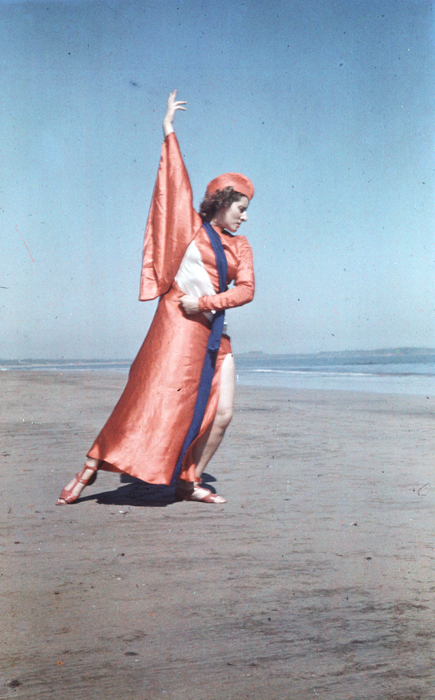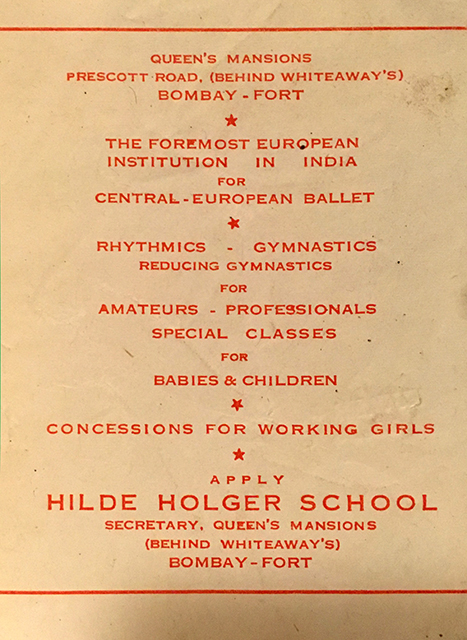Archive
Hilde Holger
- Hilde
- Holger
Hilde Sofer
- 18-10-1905
- Vienna (AT)
- 22-09-2001
- London (GB)
- ChoreographerDancerTeacher
Hilde Holger brought her expressionist dance practice from Vienna to Bombay, collaborating with local and exile artists, and opening a dance school.
Word Count: 22

Hilde Holger on Juhu Beach, 1940s. Photograph by Charles Petras. Hilde Holger Archive (© 2001 Primavera Boman-Behram. All Rights Reserved). 
Hilde Holger’s students dancing at Juhu Beach, Bombay, 1940s. Hilde Holger Archive (© 2001 Primavera Boman-Behram. All Rights Reserved). 
Advertisement for Hilde Holger’s dance school in Bombay. Hilde Holger Archive (© 2001 Primavera Boman-Behram. All Rights Reserved). “The Bombay Man's Diary: The Art of Hilde Holger” (The Evening News of India, Saturday 2 December 1939). Franz, Margit. Gateway India: Deutschsprachiges Exil in Indien zwischen britischer Kolonialherrschaft, Maharadschas und Gandhi. Graz: Clio Verein f. Geschichts- & Bildungsarbeit, 2015.
Holger, Hilde. ‘Dance Teacher in India’. Dance, September 1946.
Lupus, Krishna. ‘A Heroine in Our Midst’. BLITZ. 27 March 1948.Sassenberg, Marina. “Hilde Holger: 1905–2001.” Jewish Women’s Archive, https://jwa.org/encyclopedia/article/holger-hilde. Accessed June 29, 2020.
Word Count: 54
Hilde Holger Archive directed by Primavera Boman-Behram.
Word Count: 7
Bombay, India (1939–1948); London, UK (1948–2001)
Queen’s Mansion, Prescott Road, Fort, Bombay, (now Ghanshyam Talwatkar Marg, Mumbai) (Residence and Studio; 1939–1948); 18 Parliament Hill, Hampstead, London (Residence and Studio; 1948-1950); 27 Oval Road, Camden Town, London (Residence and Studio, 1950–2001).
- Bombay
- Rachel Lee. "Hilde Holger." METROMOD Archive, 2021, https://archive.metromod.net/viewer.p/69/2951/object/5138-7555973, last modified: 07-09-2021.
-
Magda Nachman AcharyaArtistTheatre DesignerIllustratorTeacherBombay
The political turmoil of the twentieth century took Magda Nachman from St. Petersburg to Moscow to the Russian countryside, then to Berlin during the 1920s and 1930s and, finally, to Bombay.
Word Count: 31
Charles PetrasJournalistDirectorLanguage TeacherWriterTheatre MakerArt ManagerTranslatorBombayCharles Petras was the founder and director of the international cultural centre Institute of Foreign Languages, an avant-garde theatre director and a very active promoter of international understanding and world peace.
Word Count: 31
Iconic Photo of the Progressive Artists’ Group and Their AssociatesPhotographBombayThere are two versions of the PAG photo at the opening of M.F. Husain's first solo exhibition in 1950 (published in 1996 and 2003) and two narratives about the opening.
Word Count: 28